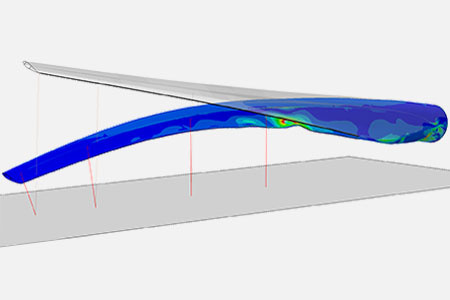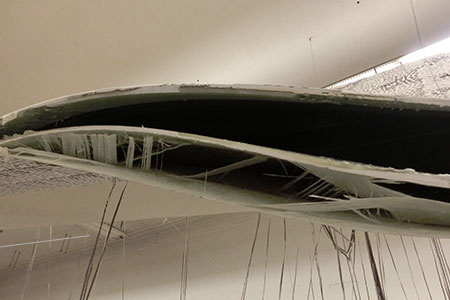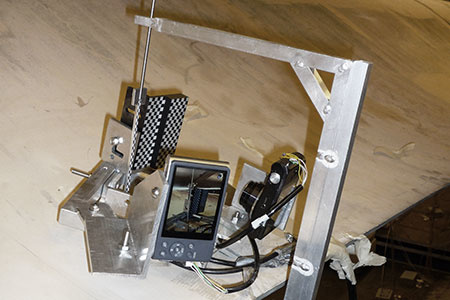News Release from windfair.net
Wind Industry Profile of
Denmark: They break turbine blades at Risø
The 300 m2 test hall at DTU Risø Campus can easily house a 30-metre wind turbine blade—and heavy equipment to pull on the blade until it breaks with a loud crash. In the course of the past four years, no fewer than three blades have been subjected to this harsh treatment, which has provided essential knowledge for blade manufacturers—and which at the end of the day, can lead to better, cheaper and safer design.
At first glance, a wind turbine seems to embody a simple streamlined design, but it actually consists of between 7,000 and 8,000 separate parts. The blade section itself is composed of several thousand parts glued together. The glue joins are often the weak points of the blades, but there may also be other reasons why a blade buckles under the constant pressure from the wind and gravity, or why it collapses under the extreme load applied by sudden and powerful gusts of wind.
If a turbine blade breaks while operating, the accident may, of course, have fatal consequences. That is why, on the one hand, the blade must be built to a given level of strength. On the other hand, however, time, money and resources can all be saved by ensuring the blade is not overly robust. It is ‘simply’ a matter of finding the right balance. Turbine manufacturers are therefore keenly interested in the destruction tests that can be run in DTU Wind Energy’s test hall.

The process in which the wind turbine blade buckles under the heavy load in the test hall is carefully documented—here using video recordings, which are compared against computer calculations.
Traction to destruction
When running a destruction test, the turbine blade is strapped onto a test bench, where it can be twisted and turned at various angles to simulate the power of the wind combined with gravity. A static load exerts downward pressure at four selected points along the blade, distorting the blade several metres from its standard position until it finally succumbs to the pressure and fragments. The entire process is documented with both video cameras and a variety of specially developed measuring instruments.
Before the huge traction machines are attached to the blades, researchers perform a series of calculations intended to identify the weakest spot of the blade in question.

Before testing begins, the researchers perform a series of calculations and simulations to determine the blade’s weakest point.
“Wind turbine blades work just like the wings of an aircraft in that they are subjected to suction on the upper side and pressure on the underside when the wind strikes the blade. And what causes an aircraft to take off, causes the rotor on a wind turbine to turn. This load is called the wind load. The second load to which the blade is subjected is gravity. If the load exceeds the blade strength, it breaks—and it is precisely the combination of the two loads on which we have made our calculations,” explains Senior Researcher Kim Branner, DTU Wind Energy, the man behind the four-year research project‘Experimental Blade Research’.
Focus on industry needs
One of the participants in the research project is the company LM Wind Power, which has produced more than 175,000 wind turbine blades since 1978 and is today the world’s leading supplier of wind turbine blades.
“Our role has been to provide industrial input. What are the challenges we are working on right now and what areas do we believe require further research? And we actually feel we’ve been listened to,” says Chief Engineer Torben Lindby.

Two cameras mounted on the blade enable researchers to see exactly what happens inside the bonded joint as the blade breaks.
New measuring equipment
Wind turbine blades consist of several thousand individual parts which are assembled using bonded joints. And bonded joints are precisely one of the blade’s weak points. The researchers therefore wanted to measure exactly what happens in the bonded joints when the entire blade is subjected to the load—a measurement that is difficult to make, as the blade buckles outwards for several metres during the experiment. It was therefore necessary to develop a new type of measuring equipment.
The measuring equipment consists of two digital cameras, a reference plate and a stick, which are connected to both sides of the blade around the trailing edge glue joint. The way in which the pin moves gives the researchers a detailed picture of what is happening inside the glue joints, and this is documented by the two cameras. “When our two eyes each see a 2D picture of reality from two different angles, our brain forms a 3D picture by combining the two images.
The same thing applies to the two cameras: The local deformation of the trailing edge of a wind turbine blade is examined from two different angles, and thus we get an idea of why it breaks,” says Senior Researcher Kim Branner, DTU Wind Energy, who adds: “Fortunately, the measurements showed that our calculations correspond well to real conditions.”
- Source:
- DTU
- Link:
- www.dtu.dk/...
